Real World Case Study: British Petroleum's Oil Spill Disaster Analysis
VerifiedAdded on 2020/02/24
|10
|2989
|725
Case Study
AI Summary
This case study examines the British Petroleum (BP) Deepwater Horizon oil spill in the Gulf of Mexico, a major project failure. The paper explores the background of BP, the events leading to the disaster, and the criteria for project success and failure. It analyzes the strengths, weaknesses, opportunities, and threats (SWOT) related to the project and provides a critical analysis of the causes of the spill, including inadequate risk management, poor decision-making, and ineffective planning. The case study highlights the importance of effective project management, stakeholder communication, and resource availability in preventing project failures. The assignment underscores the factors that contribute to project success, such as meeting budget, timelines, and quality standards, while also discussing the multifaceted nature of project success and the need for comprehensive management plans. The document concludes by offering strategic management recommendations to help firms like BP improve their project outcomes and avoid similar disasters in the future.
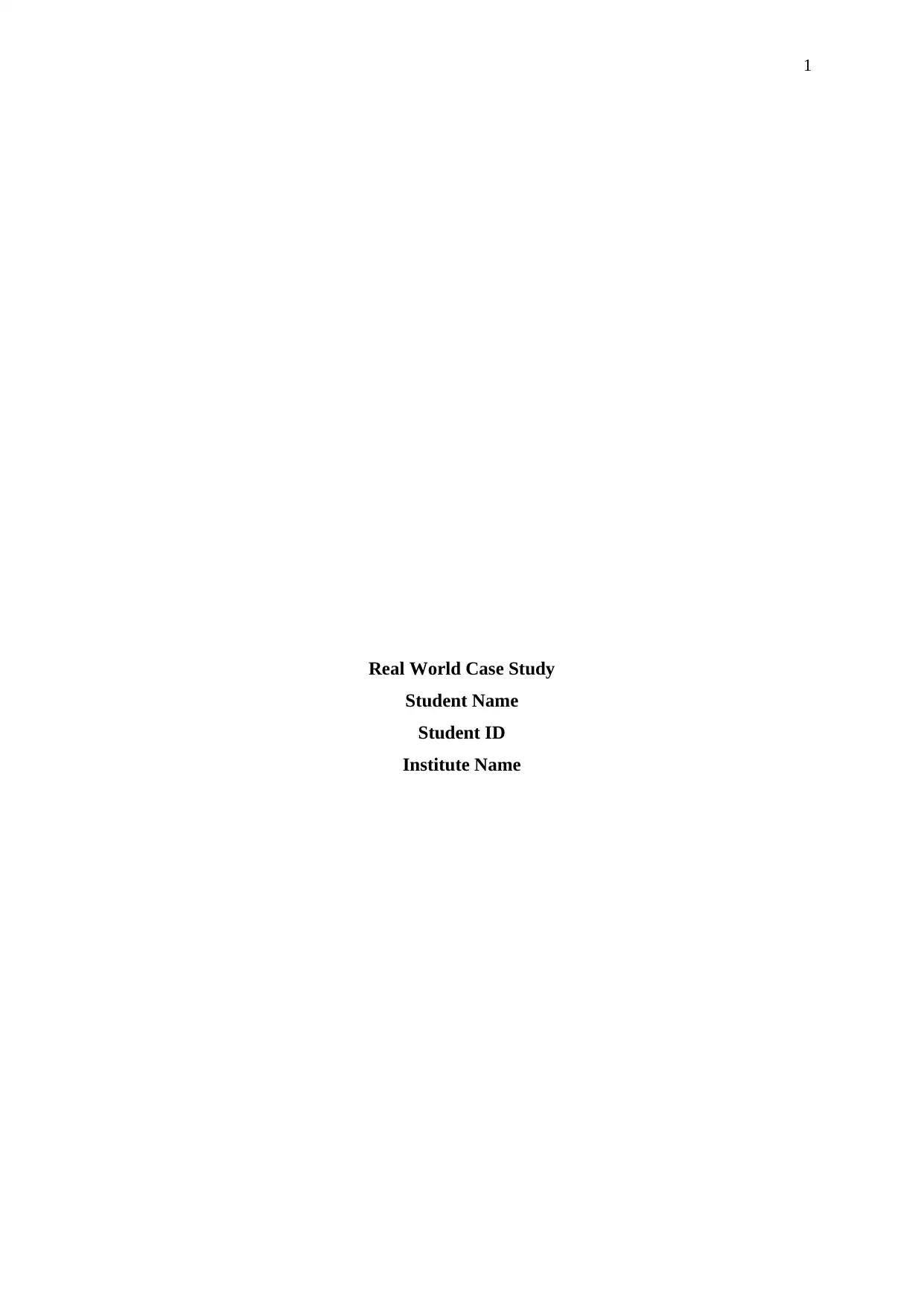
1
Real World Case Study
Student Name
Student ID
Institute Name
Real World Case Study
Student Name
Student ID
Institute Name
Paraphrase This Document
Need a fresh take? Get an instant paraphrase of this document with our AI Paraphraser
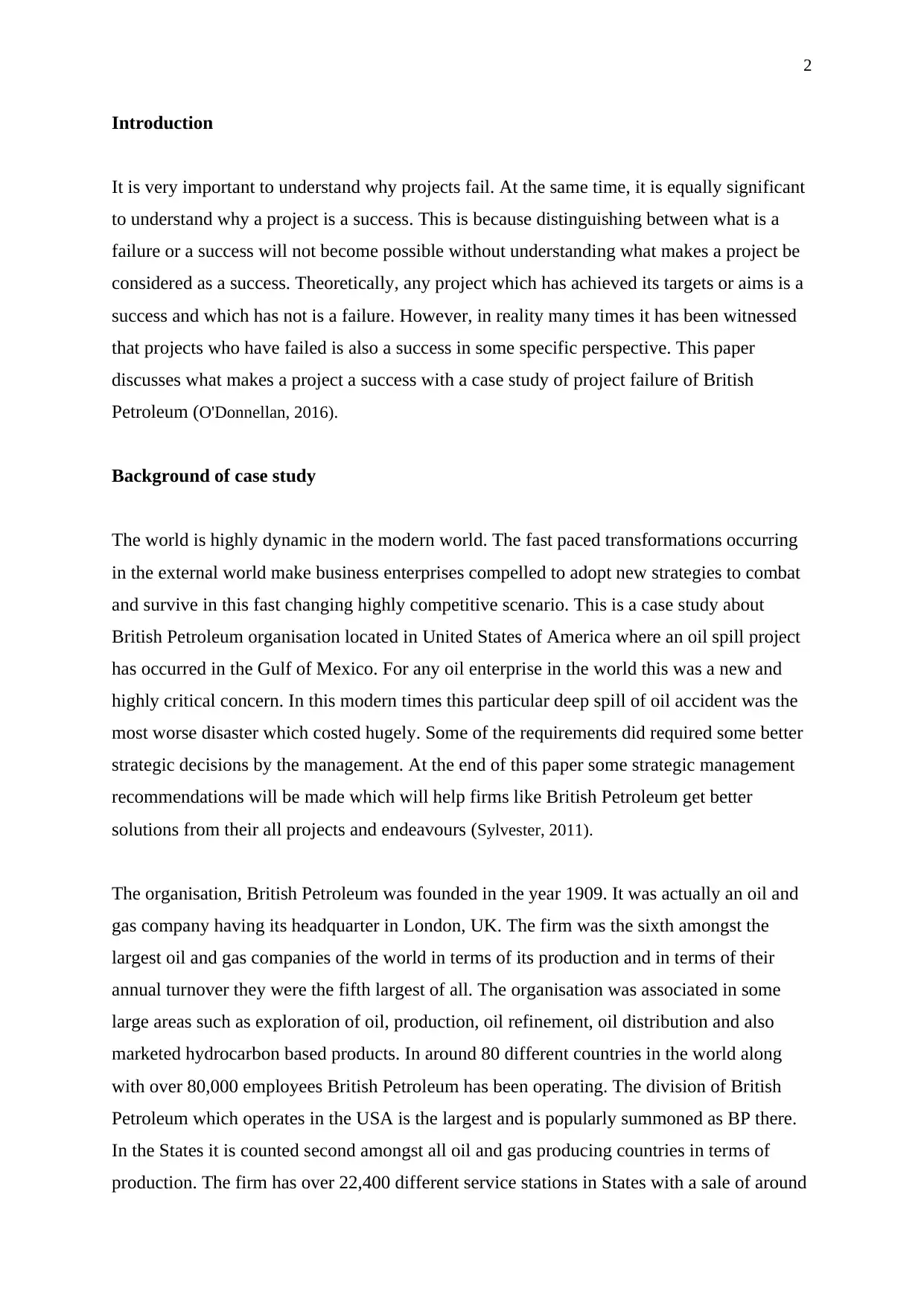
2
Introduction
It is very important to understand why projects fail. At the same time, it is equally significant
to understand why a project is a success. This is because distinguishing between what is a
failure or a success will not become possible without understanding what makes a project be
considered as a success. Theoretically, any project which has achieved its targets or aims is a
success and which has not is a failure. However, in reality many times it has been witnessed
that projects who have failed is also a success in some specific perspective. This paper
discusses what makes a project a success with a case study of project failure of British
Petroleum (O'Donnellan, 2016).
Background of case study
The world is highly dynamic in the modern world. The fast paced transformations occurring
in the external world make business enterprises compelled to adopt new strategies to combat
and survive in this fast changing highly competitive scenario. This is a case study about
British Petroleum organisation located in United States of America where an oil spill project
has occurred in the Gulf of Mexico. For any oil enterprise in the world this was a new and
highly critical concern. In this modern times this particular deep spill of oil accident was the
most worse disaster which costed hugely. Some of the requirements did required some better
strategic decisions by the management. At the end of this paper some strategic management
recommendations will be made which will help firms like British Petroleum get better
solutions from their all projects and endeavours (Sylvester, 2011).
The organisation, British Petroleum was founded in the year 1909. It was actually an oil and
gas company having its headquarter in London, UK. The firm was the sixth amongst the
largest oil and gas companies of the world in terms of its production and in terms of their
annual turnover they were the fifth largest of all. The organisation was associated in some
large areas such as exploration of oil, production, oil refinement, oil distribution and also
marketed hydrocarbon based products. In around 80 different countries in the world along
with over 80,000 employees British Petroleum has been operating. The division of British
Petroleum which operates in the USA is the largest and is popularly summoned as BP there.
In the States it is counted second amongst all oil and gas producing countries in terms of
production. The firm has over 22,400 different service stations in States with a sale of around
Introduction
It is very important to understand why projects fail. At the same time, it is equally significant
to understand why a project is a success. This is because distinguishing between what is a
failure or a success will not become possible without understanding what makes a project be
considered as a success. Theoretically, any project which has achieved its targets or aims is a
success and which has not is a failure. However, in reality many times it has been witnessed
that projects who have failed is also a success in some specific perspective. This paper
discusses what makes a project a success with a case study of project failure of British
Petroleum (O'Donnellan, 2016).
Background of case study
The world is highly dynamic in the modern world. The fast paced transformations occurring
in the external world make business enterprises compelled to adopt new strategies to combat
and survive in this fast changing highly competitive scenario. This is a case study about
British Petroleum organisation located in United States of America where an oil spill project
has occurred in the Gulf of Mexico. For any oil enterprise in the world this was a new and
highly critical concern. In this modern times this particular deep spill of oil accident was the
most worse disaster which costed hugely. Some of the requirements did required some better
strategic decisions by the management. At the end of this paper some strategic management
recommendations will be made which will help firms like British Petroleum get better
solutions from their all projects and endeavours (Sylvester, 2011).
The organisation, British Petroleum was founded in the year 1909. It was actually an oil and
gas company having its headquarter in London, UK. The firm was the sixth amongst the
largest oil and gas companies of the world in terms of its production and in terms of their
annual turnover they were the fifth largest of all. The organisation was associated in some
large areas such as exploration of oil, production, oil refinement, oil distribution and also
marketed hydrocarbon based products. In around 80 different countries in the world along
with over 80,000 employees British Petroleum has been operating. The division of British
Petroleum which operates in the USA is the largest and is popularly summoned as BP there.
In the States it is counted second amongst all oil and gas producing countries in terms of
production. The firm has over 22,400 different service stations in States with a sale of around
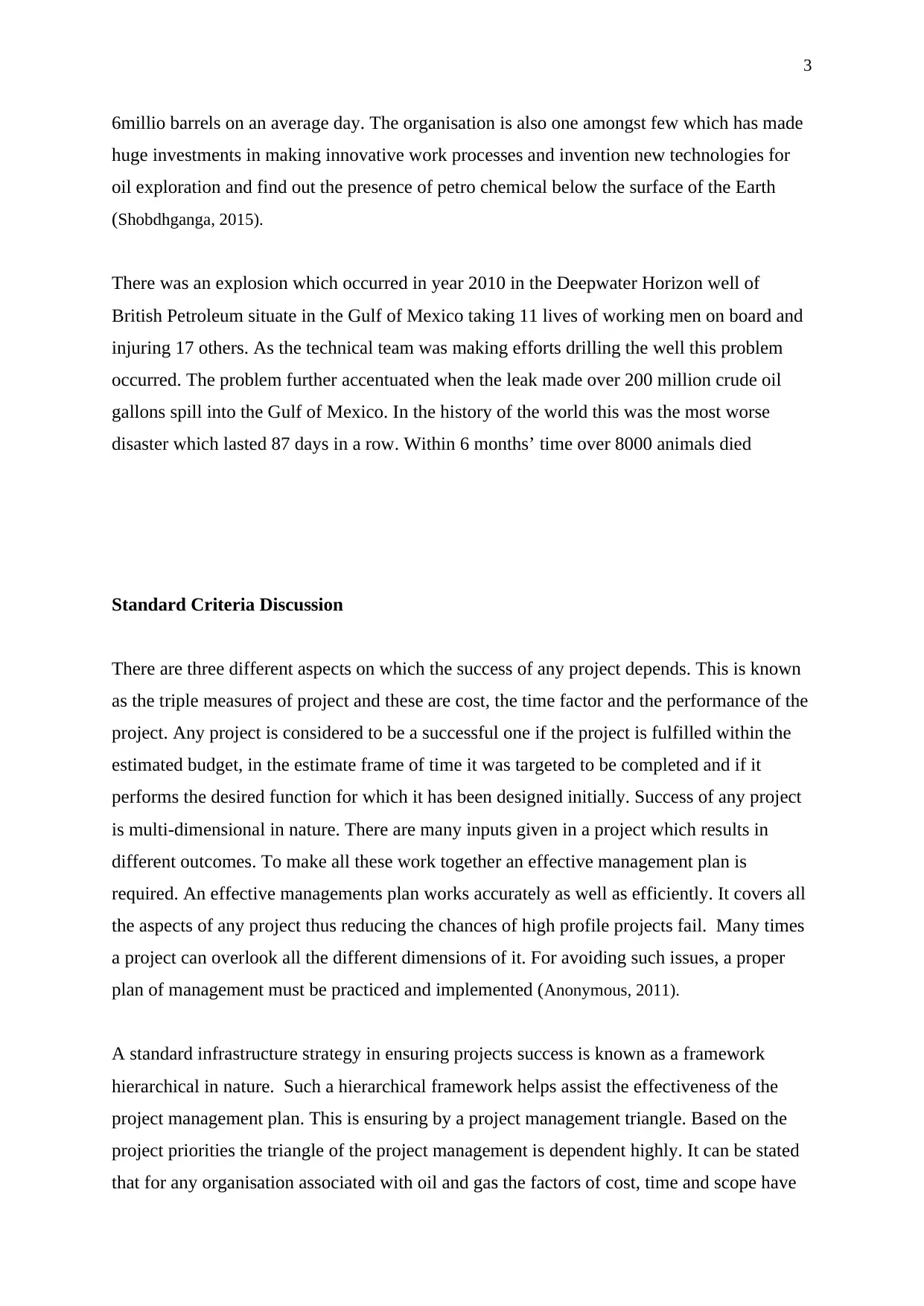
3
6millio barrels on an average day. The organisation is also one amongst few which has made
huge investments in making innovative work processes and invention new technologies for
oil exploration and find out the presence of petro chemical below the surface of the Earth
(Shobdhganga, 2015).
There was an explosion which occurred in year 2010 in the Deepwater Horizon well of
British Petroleum situate in the Gulf of Mexico taking 11 lives of working men on board and
injuring 17 others. As the technical team was making efforts drilling the well this problem
occurred. The problem further accentuated when the leak made over 200 million crude oil
gallons spill into the Gulf of Mexico. In the history of the world this was the most worse
disaster which lasted 87 days in a row. Within 6 months’ time over 8000 animals died
Standard Criteria Discussion
There are three different aspects on which the success of any project depends. This is known
as the triple measures of project and these are cost, the time factor and the performance of the
project. Any project is considered to be a successful one if the project is fulfilled within the
estimated budget, in the estimate frame of time it was targeted to be completed and if it
performs the desired function for which it has been designed initially. Success of any project
is multi-dimensional in nature. There are many inputs given in a project which results in
different outcomes. To make all these work together an effective management plan is
required. An effective managements plan works accurately as well as efficiently. It covers all
the aspects of any project thus reducing the chances of high profile projects fail. Many times
a project can overlook all the different dimensions of it. For avoiding such issues, a proper
plan of management must be practiced and implemented (Anonymous, 2011).
A standard infrastructure strategy in ensuring projects success is known as a framework
hierarchical in nature. Such a hierarchical framework helps assist the effectiveness of the
project management plan. This is ensuring by a project management triangle. Based on the
project priorities the triangle of the project management is dependent highly. It can be stated
that for any organisation associated with oil and gas the factors of cost, time and scope have
6millio barrels on an average day. The organisation is also one amongst few which has made
huge investments in making innovative work processes and invention new technologies for
oil exploration and find out the presence of petro chemical below the surface of the Earth
(Shobdhganga, 2015).
There was an explosion which occurred in year 2010 in the Deepwater Horizon well of
British Petroleum situate in the Gulf of Mexico taking 11 lives of working men on board and
injuring 17 others. As the technical team was making efforts drilling the well this problem
occurred. The problem further accentuated when the leak made over 200 million crude oil
gallons spill into the Gulf of Mexico. In the history of the world this was the most worse
disaster which lasted 87 days in a row. Within 6 months’ time over 8000 animals died
Standard Criteria Discussion
There are three different aspects on which the success of any project depends. This is known
as the triple measures of project and these are cost, the time factor and the performance of the
project. Any project is considered to be a successful one if the project is fulfilled within the
estimated budget, in the estimate frame of time it was targeted to be completed and if it
performs the desired function for which it has been designed initially. Success of any project
is multi-dimensional in nature. There are many inputs given in a project which results in
different outcomes. To make all these work together an effective management plan is
required. An effective managements plan works accurately as well as efficiently. It covers all
the aspects of any project thus reducing the chances of high profile projects fail. Many times
a project can overlook all the different dimensions of it. For avoiding such issues, a proper
plan of management must be practiced and implemented (Anonymous, 2011).
A standard infrastructure strategy in ensuring projects success is known as a framework
hierarchical in nature. Such a hierarchical framework helps assist the effectiveness of the
project management plan. This is ensuring by a project management triangle. Based on the
project priorities the triangle of the project management is dependent highly. It can be stated
that for any organisation associated with oil and gas the factors of cost, time and scope have
⊘ This is a preview!⊘
Do you want full access?
Subscribe today to unlock all pages.

Trusted by 1+ million students worldwide
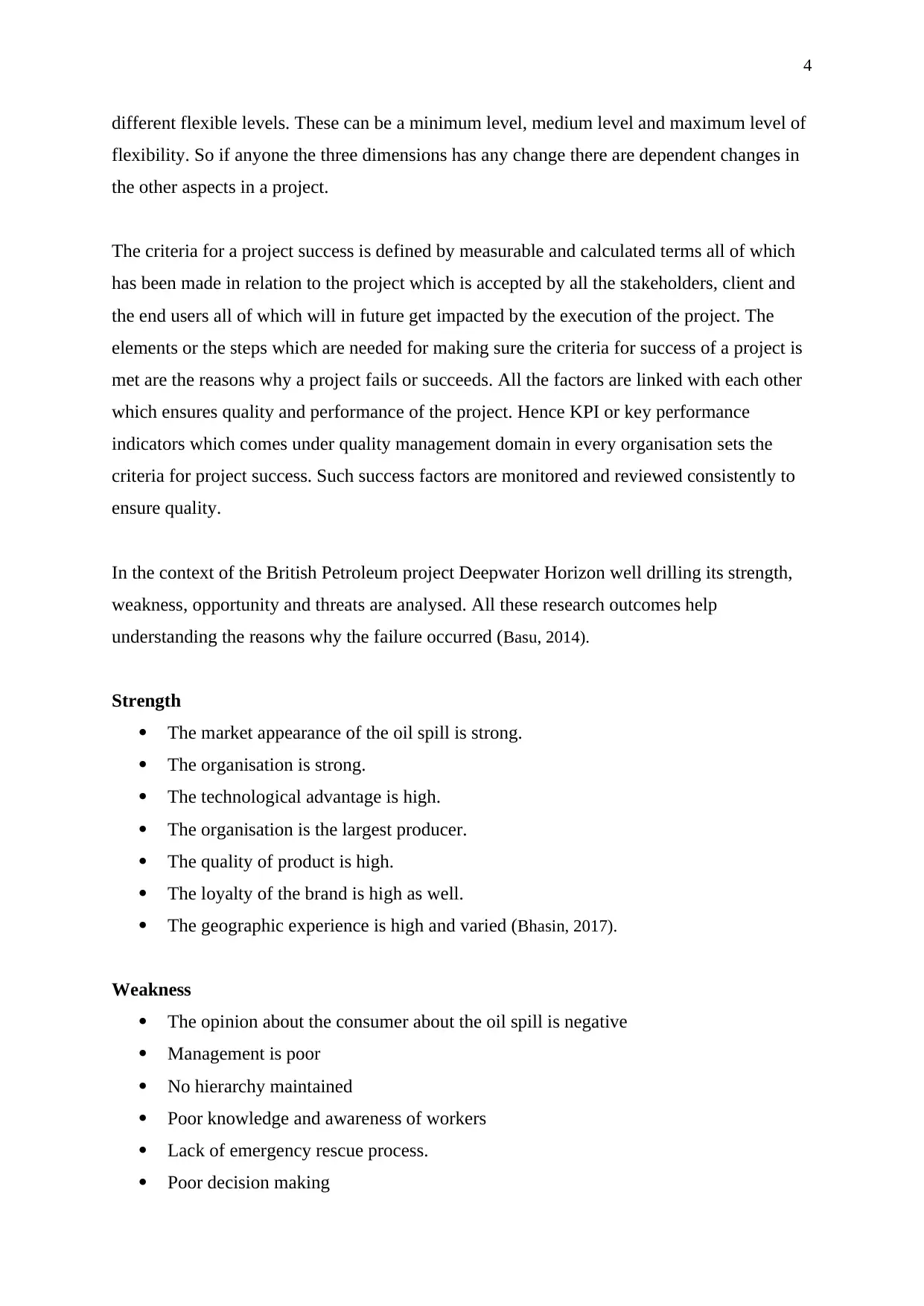
4
different flexible levels. These can be a minimum level, medium level and maximum level of
flexibility. So if anyone the three dimensions has any change there are dependent changes in
the other aspects in a project.
The criteria for a project success is defined by measurable and calculated terms all of which
has been made in relation to the project which is accepted by all the stakeholders, client and
the end users all of which will in future get impacted by the execution of the project. The
elements or the steps which are needed for making sure the criteria for success of a project is
met are the reasons why a project fails or succeeds. All the factors are linked with each other
which ensures quality and performance of the project. Hence KPI or key performance
indicators which comes under quality management domain in every organisation sets the
criteria for project success. Such success factors are monitored and reviewed consistently to
ensure quality.
In the context of the British Petroleum project Deepwater Horizon well drilling its strength,
weakness, opportunity and threats are analysed. All these research outcomes help
understanding the reasons why the failure occurred (Basu, 2014).
Strength
The market appearance of the oil spill is strong.
The organisation is strong.
The technological advantage is high.
The organisation is the largest producer.
The quality of product is high.
The loyalty of the brand is high as well.
The geographic experience is high and varied (Bhasin, 2017).
Weakness
The opinion about the consumer about the oil spill is negative
Management is poor
No hierarchy maintained
Poor knowledge and awareness of workers
Lack of emergency rescue process.
Poor decision making
different flexible levels. These can be a minimum level, medium level and maximum level of
flexibility. So if anyone the three dimensions has any change there are dependent changes in
the other aspects in a project.
The criteria for a project success is defined by measurable and calculated terms all of which
has been made in relation to the project which is accepted by all the stakeholders, client and
the end users all of which will in future get impacted by the execution of the project. The
elements or the steps which are needed for making sure the criteria for success of a project is
met are the reasons why a project fails or succeeds. All the factors are linked with each other
which ensures quality and performance of the project. Hence KPI or key performance
indicators which comes under quality management domain in every organisation sets the
criteria for project success. Such success factors are monitored and reviewed consistently to
ensure quality.
In the context of the British Petroleum project Deepwater Horizon well drilling its strength,
weakness, opportunity and threats are analysed. All these research outcomes help
understanding the reasons why the failure occurred (Basu, 2014).
Strength
The market appearance of the oil spill is strong.
The organisation is strong.
The technological advantage is high.
The organisation is the largest producer.
The quality of product is high.
The loyalty of the brand is high as well.
The geographic experience is high and varied (Bhasin, 2017).
Weakness
The opinion about the consumer about the oil spill is negative
Management is poor
No hierarchy maintained
Poor knowledge and awareness of workers
Lack of emergency rescue process.
Poor decision making
Paraphrase This Document
Need a fresh take? Get an instant paraphrase of this document with our AI Paraphraser
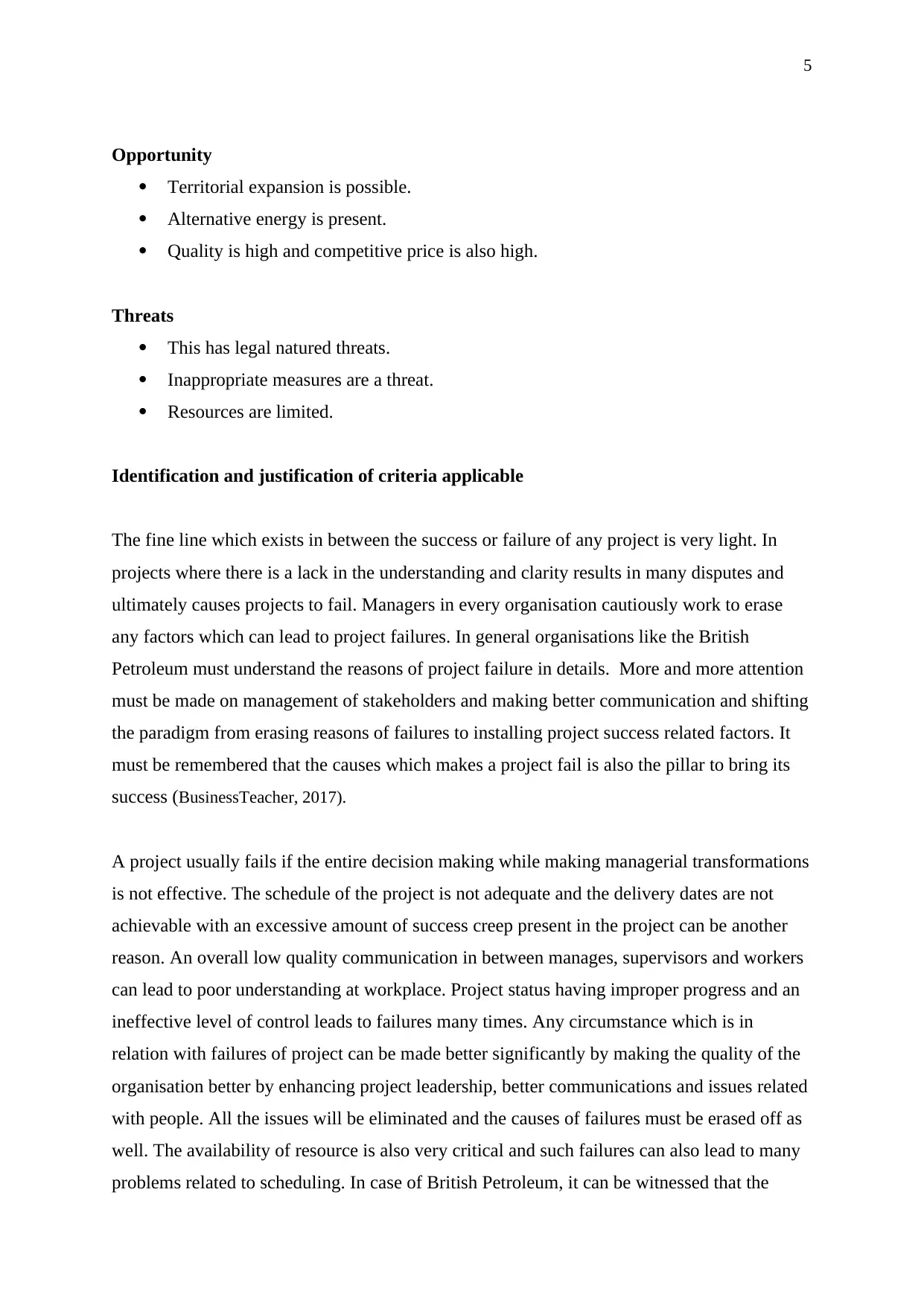
5
Opportunity
Territorial expansion is possible.
Alternative energy is present.
Quality is high and competitive price is also high.
Threats
This has legal natured threats.
Inappropriate measures are a threat.
Resources are limited.
Identification and justification of criteria applicable
The fine line which exists in between the success or failure of any project is very light. In
projects where there is a lack in the understanding and clarity results in many disputes and
ultimately causes projects to fail. Managers in every organisation cautiously work to erase
any factors which can lead to project failures. In general organisations like the British
Petroleum must understand the reasons of project failure in details. More and more attention
must be made on management of stakeholders and making better communication and shifting
the paradigm from erasing reasons of failures to installing project success related factors. It
must be remembered that the causes which makes a project fail is also the pillar to bring its
success (BusinessTeacher, 2017).
A project usually fails if the entire decision making while making managerial transformations
is not effective. The schedule of the project is not adequate and the delivery dates are not
achievable with an excessive amount of success creep present in the project can be another
reason. An overall low quality communication in between manages, supervisors and workers
can lead to poor understanding at workplace. Project status having improper progress and an
ineffective level of control leads to failures many times. Any circumstance which is in
relation with failures of project can be made better significantly by making the quality of the
organisation better by enhancing project leadership, better communications and issues related
with people. All the issues will be eliminated and the causes of failures must be erased off as
well. The availability of resource is also very critical and such failures can also lead to many
problems related to scheduling. In case of British Petroleum, it can be witnessed that the
Opportunity
Territorial expansion is possible.
Alternative energy is present.
Quality is high and competitive price is also high.
Threats
This has legal natured threats.
Inappropriate measures are a threat.
Resources are limited.
Identification and justification of criteria applicable
The fine line which exists in between the success or failure of any project is very light. In
projects where there is a lack in the understanding and clarity results in many disputes and
ultimately causes projects to fail. Managers in every organisation cautiously work to erase
any factors which can lead to project failures. In general organisations like the British
Petroleum must understand the reasons of project failure in details. More and more attention
must be made on management of stakeholders and making better communication and shifting
the paradigm from erasing reasons of failures to installing project success related factors. It
must be remembered that the causes which makes a project fail is also the pillar to bring its
success (BusinessTeacher, 2017).
A project usually fails if the entire decision making while making managerial transformations
is not effective. The schedule of the project is not adequate and the delivery dates are not
achievable with an excessive amount of success creep present in the project can be another
reason. An overall low quality communication in between manages, supervisors and workers
can lead to poor understanding at workplace. Project status having improper progress and an
ineffective level of control leads to failures many times. Any circumstance which is in
relation with failures of project can be made better significantly by making the quality of the
organisation better by enhancing project leadership, better communications and issues related
with people. All the issues will be eliminated and the causes of failures must be erased off as
well. The availability of resource is also very critical and such failures can also lead to many
problems related to scheduling. In case of British Petroleum, it can be witnessed that the
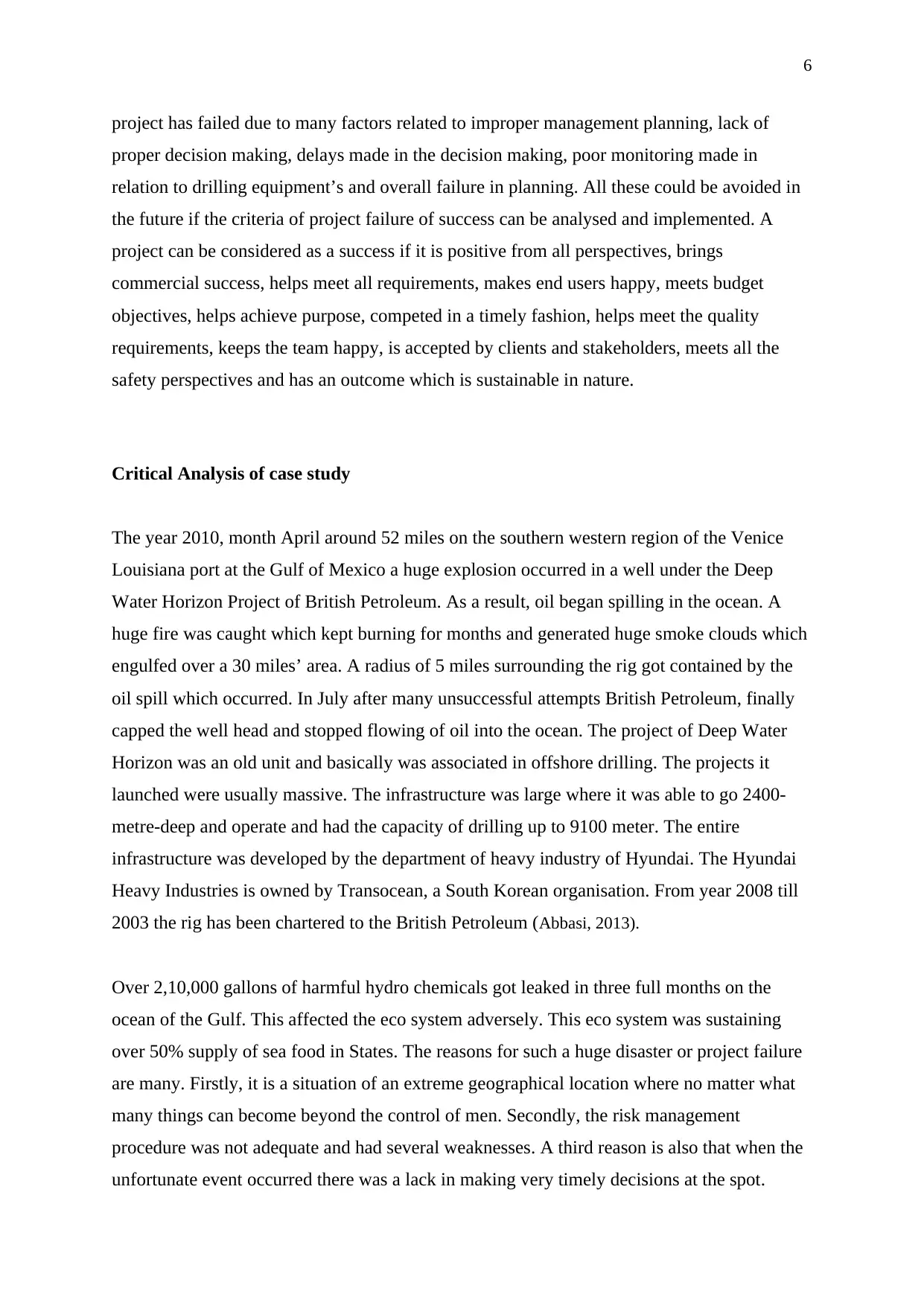
6
project has failed due to many factors related to improper management planning, lack of
proper decision making, delays made in the decision making, poor monitoring made in
relation to drilling equipment’s and overall failure in planning. All these could be avoided in
the future if the criteria of project failure of success can be analysed and implemented. A
project can be considered as a success if it is positive from all perspectives, brings
commercial success, helps meet all requirements, makes end users happy, meets budget
objectives, helps achieve purpose, competed in a timely fashion, helps meet the quality
requirements, keeps the team happy, is accepted by clients and stakeholders, meets all the
safety perspectives and has an outcome which is sustainable in nature.
Critical Analysis of case study
The year 2010, month April around 52 miles on the southern western region of the Venice
Louisiana port at the Gulf of Mexico a huge explosion occurred in a well under the Deep
Water Horizon Project of British Petroleum. As a result, oil began spilling in the ocean. A
huge fire was caught which kept burning for months and generated huge smoke clouds which
engulfed over a 30 miles’ area. A radius of 5 miles surrounding the rig got contained by the
oil spill which occurred. In July after many unsuccessful attempts British Petroleum, finally
capped the well head and stopped flowing of oil into the ocean. The project of Deep Water
Horizon was an old unit and basically was associated in offshore drilling. The projects it
launched were usually massive. The infrastructure was large where it was able to go 2400-
metre-deep and operate and had the capacity of drilling up to 9100 meter. The entire
infrastructure was developed by the department of heavy industry of Hyundai. The Hyundai
Heavy Industries is owned by Transocean, a South Korean organisation. From year 2008 till
2003 the rig has been chartered to the British Petroleum (Abbasi, 2013).
Over 2,10,000 gallons of harmful hydro chemicals got leaked in three full months on the
ocean of the Gulf. This affected the eco system adversely. This eco system was sustaining
over 50% supply of sea food in States. The reasons for such a huge disaster or project failure
are many. Firstly, it is a situation of an extreme geographical location where no matter what
many things can become beyond the control of men. Secondly, the risk management
procedure was not adequate and had several weaknesses. A third reason is also that when the
unfortunate event occurred there was a lack in making very timely decisions at the spot.
project has failed due to many factors related to improper management planning, lack of
proper decision making, delays made in the decision making, poor monitoring made in
relation to drilling equipment’s and overall failure in planning. All these could be avoided in
the future if the criteria of project failure of success can be analysed and implemented. A
project can be considered as a success if it is positive from all perspectives, brings
commercial success, helps meet all requirements, makes end users happy, meets budget
objectives, helps achieve purpose, competed in a timely fashion, helps meet the quality
requirements, keeps the team happy, is accepted by clients and stakeholders, meets all the
safety perspectives and has an outcome which is sustainable in nature.
Critical Analysis of case study
The year 2010, month April around 52 miles on the southern western region of the Venice
Louisiana port at the Gulf of Mexico a huge explosion occurred in a well under the Deep
Water Horizon Project of British Petroleum. As a result, oil began spilling in the ocean. A
huge fire was caught which kept burning for months and generated huge smoke clouds which
engulfed over a 30 miles’ area. A radius of 5 miles surrounding the rig got contained by the
oil spill which occurred. In July after many unsuccessful attempts British Petroleum, finally
capped the well head and stopped flowing of oil into the ocean. The project of Deep Water
Horizon was an old unit and basically was associated in offshore drilling. The projects it
launched were usually massive. The infrastructure was large where it was able to go 2400-
metre-deep and operate and had the capacity of drilling up to 9100 meter. The entire
infrastructure was developed by the department of heavy industry of Hyundai. The Hyundai
Heavy Industries is owned by Transocean, a South Korean organisation. From year 2008 till
2003 the rig has been chartered to the British Petroleum (Abbasi, 2013).
Over 2,10,000 gallons of harmful hydro chemicals got leaked in three full months on the
ocean of the Gulf. This affected the eco system adversely. This eco system was sustaining
over 50% supply of sea food in States. The reasons for such a huge disaster or project failure
are many. Firstly, it is a situation of an extreme geographical location where no matter what
many things can become beyond the control of men. Secondly, the risk management
procedure was not adequate and had several weaknesses. A third reason is also that when the
unfortunate event occurred there was a lack in making very timely decisions at the spot.
⊘ This is a preview!⊘
Do you want full access?
Subscribe today to unlock all pages.

Trusted by 1+ million students worldwide
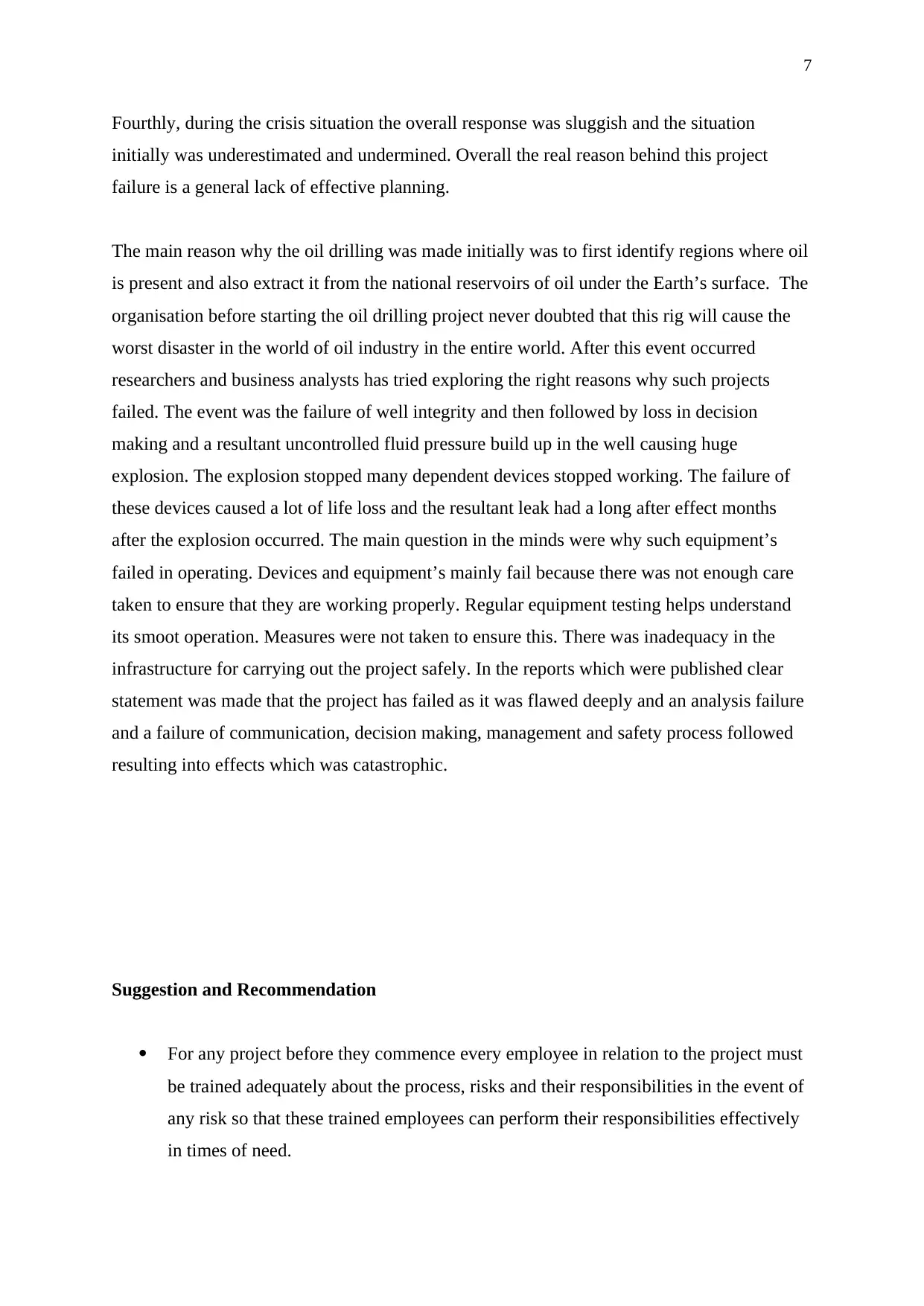
7
Fourthly, during the crisis situation the overall response was sluggish and the situation
initially was underestimated and undermined. Overall the real reason behind this project
failure is a general lack of effective planning.
The main reason why the oil drilling was made initially was to first identify regions where oil
is present and also extract it from the national reservoirs of oil under the Earth’s surface. The
organisation before starting the oil drilling project never doubted that this rig will cause the
worst disaster in the world of oil industry in the entire world. After this event occurred
researchers and business analysts has tried exploring the right reasons why such projects
failed. The event was the failure of well integrity and then followed by loss in decision
making and a resultant uncontrolled fluid pressure build up in the well causing huge
explosion. The explosion stopped many dependent devices stopped working. The failure of
these devices caused a lot of life loss and the resultant leak had a long after effect months
after the explosion occurred. The main question in the minds were why such equipment’s
failed in operating. Devices and equipment’s mainly fail because there was not enough care
taken to ensure that they are working properly. Regular equipment testing helps understand
its smoot operation. Measures were not taken to ensure this. There was inadequacy in the
infrastructure for carrying out the project safely. In the reports which were published clear
statement was made that the project has failed as it was flawed deeply and an analysis failure
and a failure of communication, decision making, management and safety process followed
resulting into effects which was catastrophic.
Suggestion and Recommendation
For any project before they commence every employee in relation to the project must
be trained adequately about the process, risks and their responsibilities in the event of
any risk so that these trained employees can perform their responsibilities effectively
in times of need.
Fourthly, during the crisis situation the overall response was sluggish and the situation
initially was underestimated and undermined. Overall the real reason behind this project
failure is a general lack of effective planning.
The main reason why the oil drilling was made initially was to first identify regions where oil
is present and also extract it from the national reservoirs of oil under the Earth’s surface. The
organisation before starting the oil drilling project never doubted that this rig will cause the
worst disaster in the world of oil industry in the entire world. After this event occurred
researchers and business analysts has tried exploring the right reasons why such projects
failed. The event was the failure of well integrity and then followed by loss in decision
making and a resultant uncontrolled fluid pressure build up in the well causing huge
explosion. The explosion stopped many dependent devices stopped working. The failure of
these devices caused a lot of life loss and the resultant leak had a long after effect months
after the explosion occurred. The main question in the minds were why such equipment’s
failed in operating. Devices and equipment’s mainly fail because there was not enough care
taken to ensure that they are working properly. Regular equipment testing helps understand
its smoot operation. Measures were not taken to ensure this. There was inadequacy in the
infrastructure for carrying out the project safely. In the reports which were published clear
statement was made that the project has failed as it was flawed deeply and an analysis failure
and a failure of communication, decision making, management and safety process followed
resulting into effects which was catastrophic.
Suggestion and Recommendation
For any project before they commence every employee in relation to the project must
be trained adequately about the process, risks and their responsibilities in the event of
any risk so that these trained employees can perform their responsibilities effectively
in times of need.
Paraphrase This Document
Need a fresh take? Get an instant paraphrase of this document with our AI Paraphraser
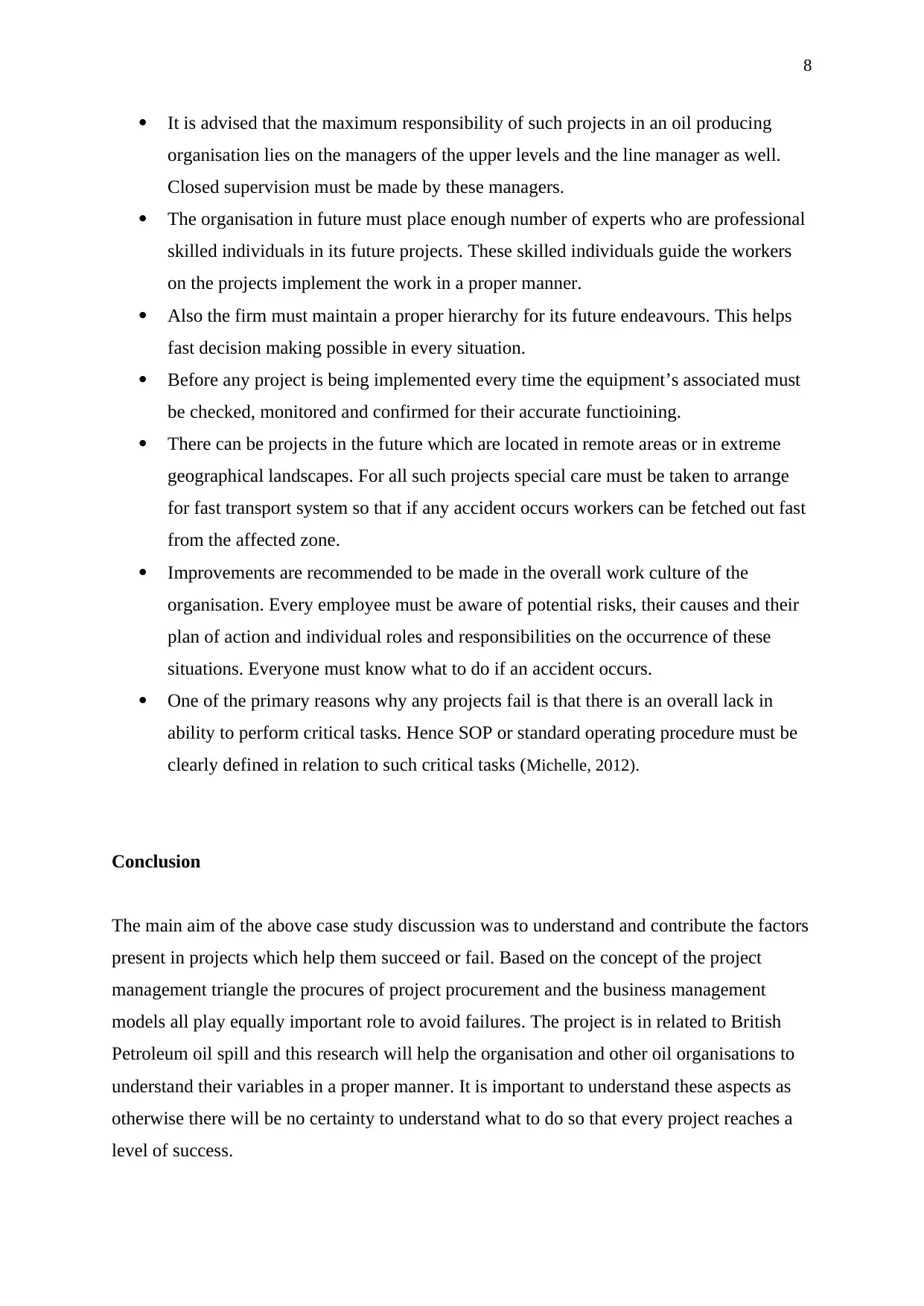
8
It is advised that the maximum responsibility of such projects in an oil producing
organisation lies on the managers of the upper levels and the line manager as well.
Closed supervision must be made by these managers.
The organisation in future must place enough number of experts who are professional
skilled individuals in its future projects. These skilled individuals guide the workers
on the projects implement the work in a proper manner.
Also the firm must maintain a proper hierarchy for its future endeavours. This helps
fast decision making possible in every situation.
Before any project is being implemented every time the equipment’s associated must
be checked, monitored and confirmed for their accurate functioining.
There can be projects in the future which are located in remote areas or in extreme
geographical landscapes. For all such projects special care must be taken to arrange
for fast transport system so that if any accident occurs workers can be fetched out fast
from the affected zone.
Improvements are recommended to be made in the overall work culture of the
organisation. Every employee must be aware of potential risks, their causes and their
plan of action and individual roles and responsibilities on the occurrence of these
situations. Everyone must know what to do if an accident occurs.
One of the primary reasons why any projects fail is that there is an overall lack in
ability to perform critical tasks. Hence SOP or standard operating procedure must be
clearly defined in relation to such critical tasks (Michelle, 2012).
Conclusion
The main aim of the above case study discussion was to understand and contribute the factors
present in projects which help them succeed or fail. Based on the concept of the project
management triangle the procures of project procurement and the business management
models all play equally important role to avoid failures. The project is in related to British
Petroleum oil spill and this research will help the organisation and other oil organisations to
understand their variables in a proper manner. It is important to understand these aspects as
otherwise there will be no certainty to understand what to do so that every project reaches a
level of success.
It is advised that the maximum responsibility of such projects in an oil producing
organisation lies on the managers of the upper levels and the line manager as well.
Closed supervision must be made by these managers.
The organisation in future must place enough number of experts who are professional
skilled individuals in its future projects. These skilled individuals guide the workers
on the projects implement the work in a proper manner.
Also the firm must maintain a proper hierarchy for its future endeavours. This helps
fast decision making possible in every situation.
Before any project is being implemented every time the equipment’s associated must
be checked, monitored and confirmed for their accurate functioining.
There can be projects in the future which are located in remote areas or in extreme
geographical landscapes. For all such projects special care must be taken to arrange
for fast transport system so that if any accident occurs workers can be fetched out fast
from the affected zone.
Improvements are recommended to be made in the overall work culture of the
organisation. Every employee must be aware of potential risks, their causes and their
plan of action and individual roles and responsibilities on the occurrence of these
situations. Everyone must know what to do if an accident occurs.
One of the primary reasons why any projects fail is that there is an overall lack in
ability to perform critical tasks. Hence SOP or standard operating procedure must be
clearly defined in relation to such critical tasks (Michelle, 2012).
Conclusion
The main aim of the above case study discussion was to understand and contribute the factors
present in projects which help them succeed or fail. Based on the concept of the project
management triangle the procures of project procurement and the business management
models all play equally important role to avoid failures. The project is in related to British
Petroleum oil spill and this research will help the organisation and other oil organisations to
understand their variables in a proper manner. It is important to understand these aspects as
otherwise there will be no certainty to understand what to do so that every project reaches a
level of success.
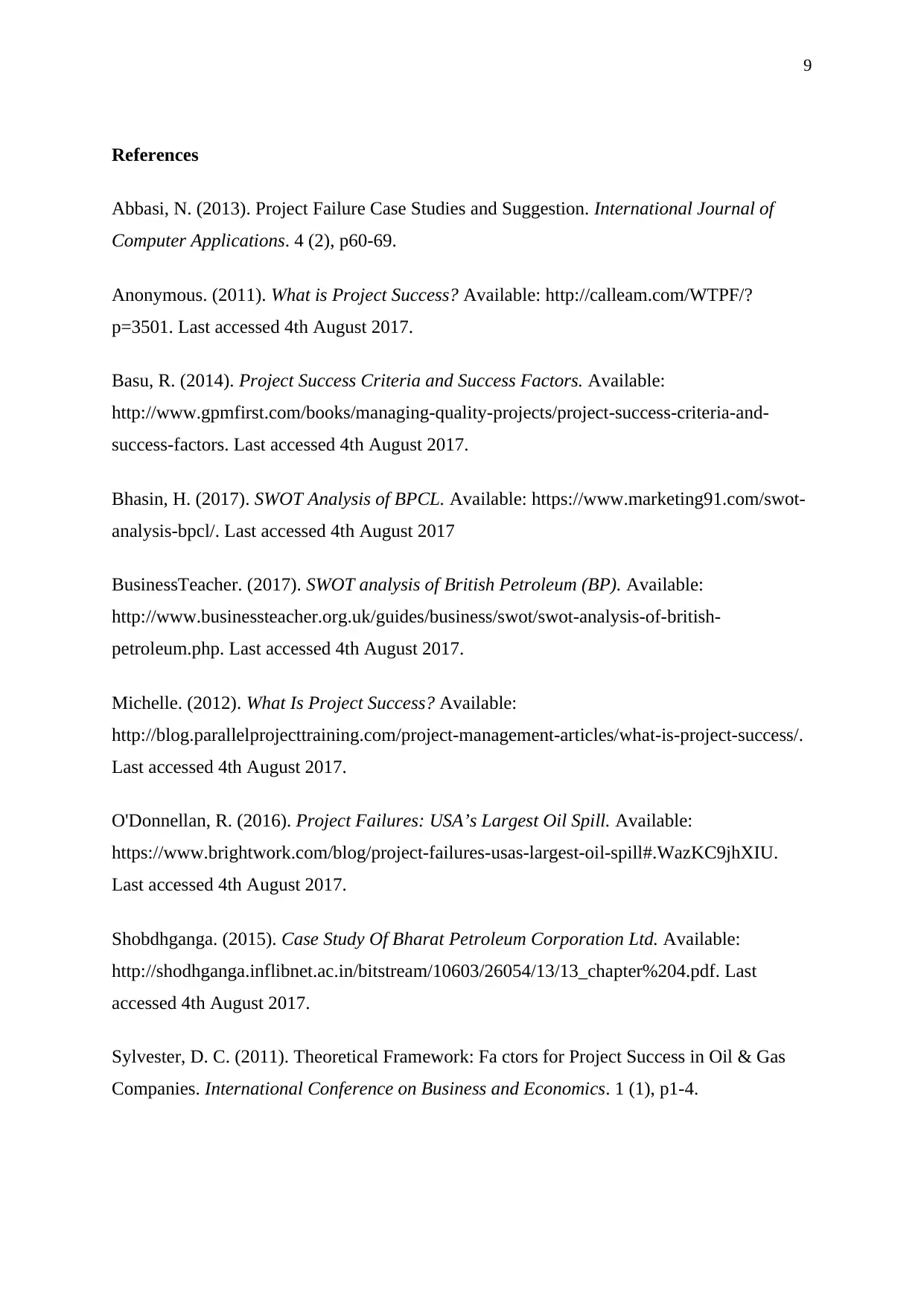
9
References
Abbasi, N. (2013). Project Failure Case Studies and Suggestion. International Journal of
Computer Applications. 4 (2), p60-69.
Anonymous. (2011). What is Project Success? Available: http://calleam.com/WTPF/?
p=3501. Last accessed 4th August 2017.
Basu, R. (2014). Project Success Criteria and Success Factors. Available:
http://www.gpmfirst.com/books/managing-quality-projects/project-success-criteria-and-
success-factors. Last accessed 4th August 2017.
Bhasin, H. (2017). SWOT Analysis of BPCL. Available: https://www.marketing91.com/swot-
analysis-bpcl/. Last accessed 4th August 2017
BusinessTeacher. (2017). SWOT analysis of British Petroleum (BP). Available:
http://www.businessteacher.org.uk/guides/business/swot/swot-analysis-of-british-
petroleum.php. Last accessed 4th August 2017.
Michelle. (2012). What Is Project Success? Available:
http://blog.parallelprojecttraining.com/project-management-articles/what-is-project-success/.
Last accessed 4th August 2017.
O'Donnellan, R. (2016). Project Failures: USA’s Largest Oil Spill. Available:
https://www.brightwork.com/blog/project-failures-usas-largest-oil-spill#.WazKC9jhXIU.
Last accessed 4th August 2017.
Shobdhganga. (2015). Case Study Of Bharat Petroleum Corporation Ltd. Available:
http://shodhganga.inflibnet.ac.in/bitstream/10603/26054/13/13_chapter%204.pdf. Last
accessed 4th August 2017.
Sylvester, D. C. (2011). Theoretical Framework: Fa ctors for Project Success in Oil & Gas
Companies. International Conference on Business and Economics. 1 (1), p1-4.
References
Abbasi, N. (2013). Project Failure Case Studies and Suggestion. International Journal of
Computer Applications. 4 (2), p60-69.
Anonymous. (2011). What is Project Success? Available: http://calleam.com/WTPF/?
p=3501. Last accessed 4th August 2017.
Basu, R. (2014). Project Success Criteria and Success Factors. Available:
http://www.gpmfirst.com/books/managing-quality-projects/project-success-criteria-and-
success-factors. Last accessed 4th August 2017.
Bhasin, H. (2017). SWOT Analysis of BPCL. Available: https://www.marketing91.com/swot-
analysis-bpcl/. Last accessed 4th August 2017
BusinessTeacher. (2017). SWOT analysis of British Petroleum (BP). Available:
http://www.businessteacher.org.uk/guides/business/swot/swot-analysis-of-british-
petroleum.php. Last accessed 4th August 2017.
Michelle. (2012). What Is Project Success? Available:
http://blog.parallelprojecttraining.com/project-management-articles/what-is-project-success/.
Last accessed 4th August 2017.
O'Donnellan, R. (2016). Project Failures: USA’s Largest Oil Spill. Available:
https://www.brightwork.com/blog/project-failures-usas-largest-oil-spill#.WazKC9jhXIU.
Last accessed 4th August 2017.
Shobdhganga. (2015). Case Study Of Bharat Petroleum Corporation Ltd. Available:
http://shodhganga.inflibnet.ac.in/bitstream/10603/26054/13/13_chapter%204.pdf. Last
accessed 4th August 2017.
Sylvester, D. C. (2011). Theoretical Framework: Fa ctors for Project Success in Oil & Gas
Companies. International Conference on Business and Economics. 1 (1), p1-4.
⊘ This is a preview!⊘
Do you want full access?
Subscribe today to unlock all pages.

Trusted by 1+ million students worldwide

10
1 out of 10
Related Documents
Your All-in-One AI-Powered Toolkit for Academic Success.
+13062052269
info@desklib.com
Available 24*7 on WhatsApp / Email
![[object Object]](/_next/static/media/star-bottom.7253800d.svg)
Unlock your academic potential
Copyright © 2020–2025 A2Z Services. All Rights Reserved. Developed and managed by ZUCOL.





